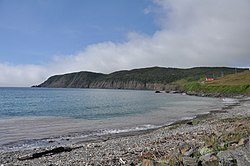Town of Branch | |
|---|---|
Town | |
 View of the town of Branch from Route 92 | |
Location of Branch in Newfoundland | |
| Coordinates: 46°53′00″N53°58′00″W / 46.88333°N 53.96667°W | |
| Country | |
| Province | |
| Government | |
| • Mayor | Kelly Power |
| Area | |
| • Land | 16.18 km2 (6.25 sq mi) |
| Population (2021) [1] | |
• Total | 223 |
| • Density | 13.8/km2 (36/sq mi) |
| Time zone | UTC-3:30 (Newfoundland Time) |
| • Summer (DST) | UTC-2:30 (Newfoundland Daylight) |
| Area code | 709 |
| Highways | |
The Town of Branch is an incorporated community of Newfoundland and Labrador, Canada and had a population of 223 (as of the 2021 census). [1]


